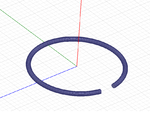drkirkby
Full Member level 6
I want to model a loop antenna, but are not sure how to draw the loop. I have seen this done in the past, and if I recall correctly, a circle is drawn, and then that swept along a arc. But I can't seem to find out / recall how to do it.
I did think of drawing a torus, then chopping a bit out by drawing a box over the torus, and doing a subtraction. So essentially putting a cut through the torus.
Any ideas? I have access to HFSS 14.
I'm guessing driven model with a lumped port is optimal. I say that, as that is what is used on a dipole in the HFSS antenna design tool. This seems pretty close to that sort of thing.
I did think of drawing a torus, then chopping a bit out by drawing a box over the torus, and doing a subtraction. So essentially putting a cut through the torus.
Any ideas? I have access to HFSS 14.
I'm guessing driven model with a lumped port is optimal. I say that, as that is what is used on a dipole in the HFSS antenna design tool. This seems pretty close to that sort of thing.






